Wanted to look at the review history of a JEB paper from a mere two years ago - but hosted on publons so gone forever?
07.10.2025 17:14 — 👍 0 🔁 0 💬 0 📌 0Wouter van der Bijl
@vdbijl.bsky.social
Evolutionary biologist @ UBC.
@vdbijl.bsky.social
Evolutionary biologist @ UBC.
Wanted to look at the review history of a JEB paper from a mere two years ago - but hosted on publons so gone forever?
07.10.2025 17:14 — 👍 0 🔁 0 💬 0 📌 0Thanks Andrew!
09.09.2025 21:52 — 👍 0 🔁 0 💬 0 📌 0While we all share our sequencing data freely, image datasets like these are still often kept private.
I am only aware of a single other study on guppy coloration (there are many!) where images are available, and it's also from our lab (Morris et al. 2020).
I hope this can improve in the future!
Our paper on the genetics of guppy color patterns has now been assigned an issue in NEE: doi.org/10.1038/s415...
With this paper, we also publish all 14,100 guppy photos used in the study, including before and after alignment and ornament extraction:
doi.org/10.20383/103...
Now published @natecoevo.nature.com with @annika-nichols.bsky.social, our latest on the evolution of 𝘴𝘭𝘦𝘦𝘱 across 𝟲𝟬 𝘀𝗽𝗲𝗰𝗶𝗲𝘀 of cichlid fishes! doi.org/10.1038/s415...
with members of the @schierlab.bsky.social and Salzburger labs, as well as the burgeoning Shafer lab @uoftcellsysbiol.bsky.social

Full paper now out in GENETICS:
The relationship between sexual dimorphism and intersex correlation: do models support intuition?
🔗 academic.oup.com/genetics/art...
#Evolution #QuantGenetics @GeneticsGSA

Many of us are using LLMs in coding and scientific writing. They are very helpful tools, but we need to be thoughtful as we integrate them into our work flows to preserve accountability, voice and trust. academic.oup.com/evlett/advan.... An editorial at @evolletters.bsky.social for discussion:
22.08.2025 12:52 — 👍 69 🔁 33 💬 2 📌 3Yes I personally prefer to use “deep learning” over “AI”. Not much use for LLMs for now (but perhaps for eg meta-analyses in a couple of years?), but transformer architecture may still hold a lot of promise for sequence data.. Time will tell.
22.08.2025 06:51 — 👍 2 🔁 0 💬 0 📌 0And yes, we used unets for segmentation.
22.08.2025 05:57 — 👍 2 🔁 0 💬 1 📌 0
Guppies! ;) I didn’t talk about it, but we also use triplet learning to do GWAS on whole patterns: doi.org/10.1038/s415.... There were quite a few posters on neural nets for image analysis and this is a domain where one can be effective with modest sample sizes.
22.08.2025 05:55 — 👍 3 🔁 0 💬 1 📌 0
ESEB Day 3! Molecular clocks & identifying ghost lineages; marrying micro & macro evolution; female polymorphism; balancing selection in round-nose grenadier; the genetics of guppy colour polymorphisms; modelling genetic interactions; antagonist selection in flying ants
#eseb2025 #eseb #sciart
Just in time for her #eseb2025 poster on Thursday, @squarehare.bsky.social 's paper on the Poecilia bifurca sex chromosomes was published today academic.oup.com/g3journal/ad...
20.08.2025 18:42 — 👍 25 🔁 7 💬 0 📌 0I hate conference apps with a passion.
19.08.2025 10:02 — 👍 2 🔁 0 💬 0 📌 0This website seems odd, it assumes MEPs will vote along country blocks, not European or individual parties?
15.08.2025 19:27 — 👍 0 🔁 0 💬 2 📌 0I’m really sorry to be missing #eseb2025, but for those sorting out their conference plan there are several lab talks and posters about what we are up to. Spoiler, they aren't all talking about guppies, or even fish! 1/n
14.08.2025 15:26 — 👍 8 🔁 3 💬 1 📌 0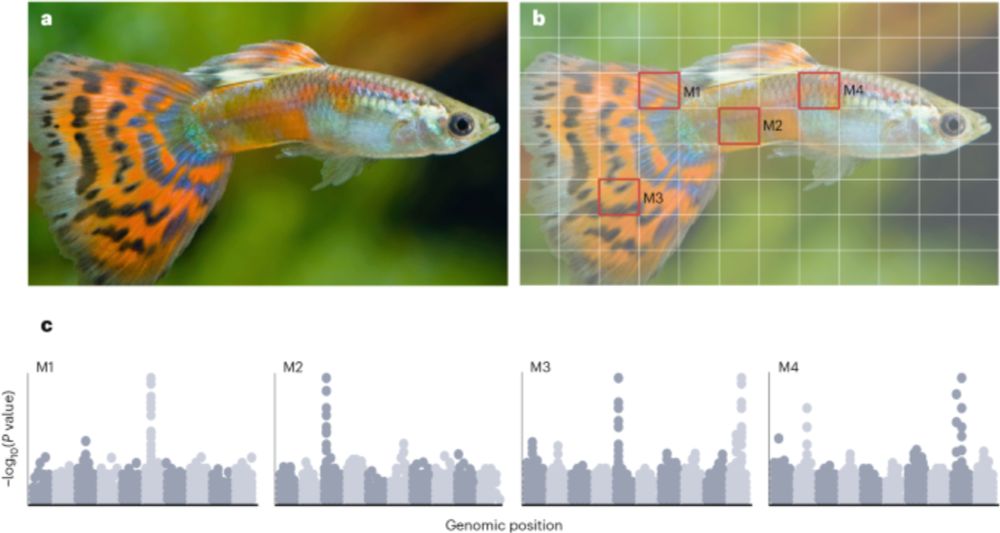
A really lovely commentary on @vdbijl.bsky.social's paper by Nidal Karagic and Claudius Kratochwil in @natecoevo.nature.com www.nature.com/articles/s41...
17.07.2025 18:53 — 👍 37 🔁 8 💬 0 📌 0Thanks Will, hope you’re doing well!
03.07.2025 14:16 — 👍 0 🔁 0 💬 0 📌 0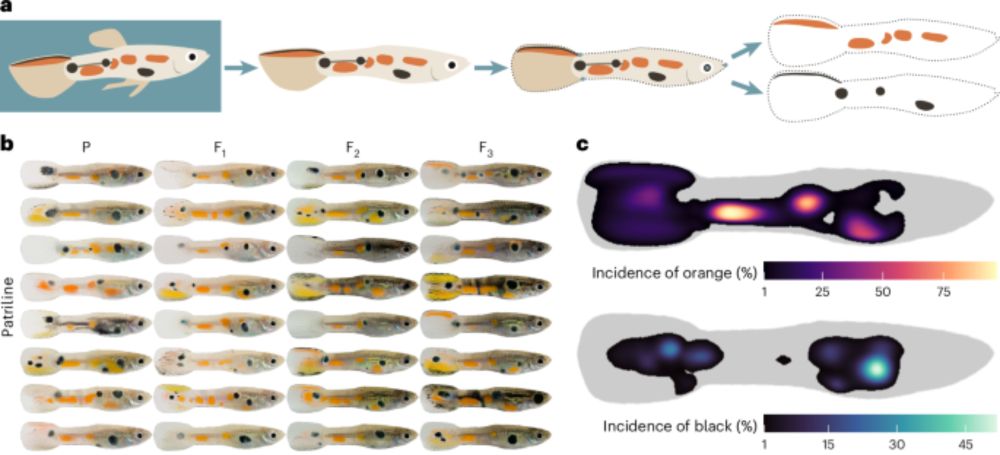
Guppy colouration is a very diverse trait under natural and sexual selection. Using a combination of high-resolution phenotyping and genomic analysis, the authors reveal the genetic architecture of this complex trait www.nature.com/articles/s41...
02.07.2025 14:53 — 👍 19 🔁 6 💬 0 📌 0This is amazing work and a great thread, revealing the hidden genetic complexity behind the equally complex pigmentation patterns. Check it out! 🧪
01.07.2025 18:33 — 👍 22 🔁 2 💬 0 📌 1Yes I’ll be there.
01.07.2025 21:43 — 👍 1 🔁 0 💬 0 📌 0Thanks a lot Alex!! Guppies continue to be amazing.
01.07.2025 19:11 — 👍 1 🔁 0 💬 1 📌 0Thanks Chris!
01.07.2025 18:35 — 👍 0 🔁 0 💬 0 📌 0Thanks Stephen!! And congrats to you on the new gig!
01.07.2025 18:31 — 👍 1 🔁 0 💬 1 📌 0This paper is the result of years of hard work, and would not have been possible without all the help from my co-authors. Special thanks to @jacejostles.bsky.social for taking ~8k photos (+fig 1a), and to @judithmank.bsky.social for her unwavering support of this project.
01.07.2025 18:17 — 👍 6 🔁 0 💬 3 📌 0Overall, the color patterns are made up of a patchwork of ornaments. The genetic architecture is much more complex than previously appreciated.
Duplications from the autosomes to the sex chromosomes play a large role in the evolution of the extreme variation in this species.
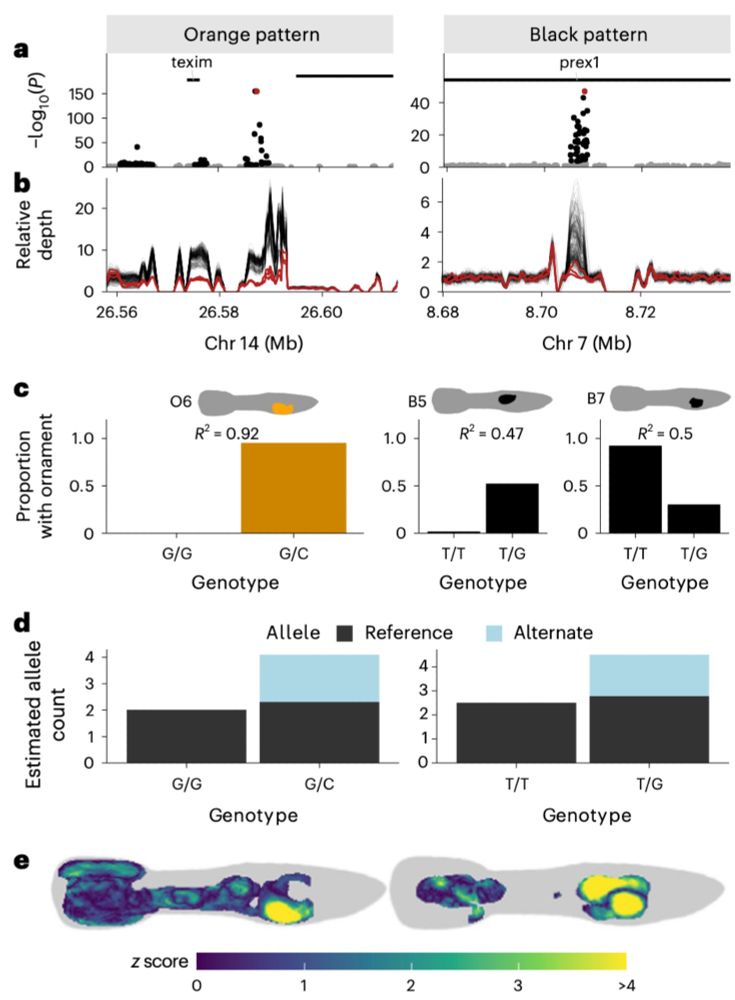
Large-effect CNVs underlie sex-linked variation in colour pattern. a, GWAS peaks on autosomes with significant loci with sex-linked inheritance, near texim and in prex1. b, The relative coverage (1× = genome-wide sample average) across the region for 297 males (this study) and 3 females, calculated in moving windows of 1 kb, 100 bp apart. c, Phenotypic effects of the top variant (diamond in a) on ornaments O6 (orange pattern) and B5 and B7 (black pattern). The proportion of variation in the phenotype that is explained by the top SNP is displayed as Nagelkerke’s R2 from a logistic regression. d, Median estimated allele counts for the top SNP, based on read depth, for homozygous reference and heterozygous individuals. No heterozygous alternate individuals were found. e, PheWAS heat maps displaying z scores for the effect of the top variant on orange and black colour across the body, controlling for autosomal and sex-linked relatedness.
The sex-linked ornaments instead show loci of very large effect at copy number variants. The locus of largest effect for orange pattern is at texim, a gene with many duplications to the Y. For black, the largest effect loci is prex1, an X-linked CNV with a know role in NCC migration.
01.07.2025 18:13 — 👍 6 🔁 1 💬 1 📌 0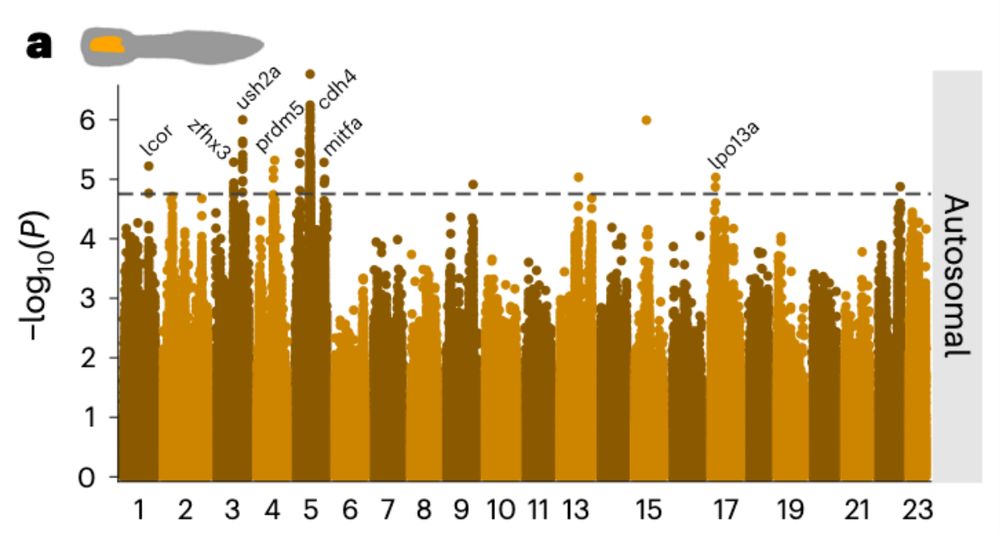
A Manhattan plot showing the association of genomic variants with ornament O2. Points represent genomic variants, with their genomic location on the x axis and the two-sided P value of the association on the y axis (from mixed effects GWAS). P values are displayed as uncorrected for multiple testing, with the dotted line denoting the 5% FDR level.
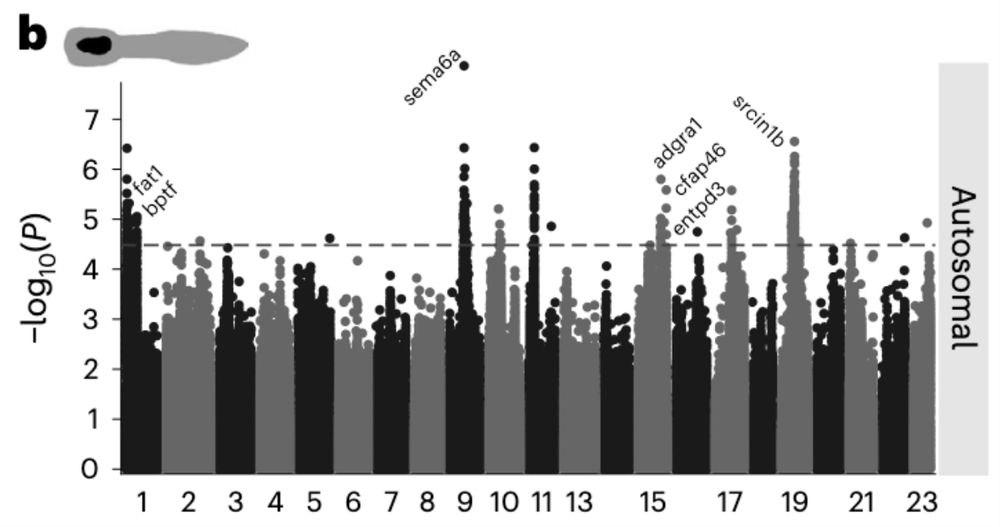
As the first figure, but for ornament B1.
Next, we sequenced 300 males to map this variation to the genome.
First, for autosomal ornaments we find a polygenic architecture. Many of the loci are near genes involved in neural crest cell migration. These cells later develop into the chromatophores responsible for coloration.
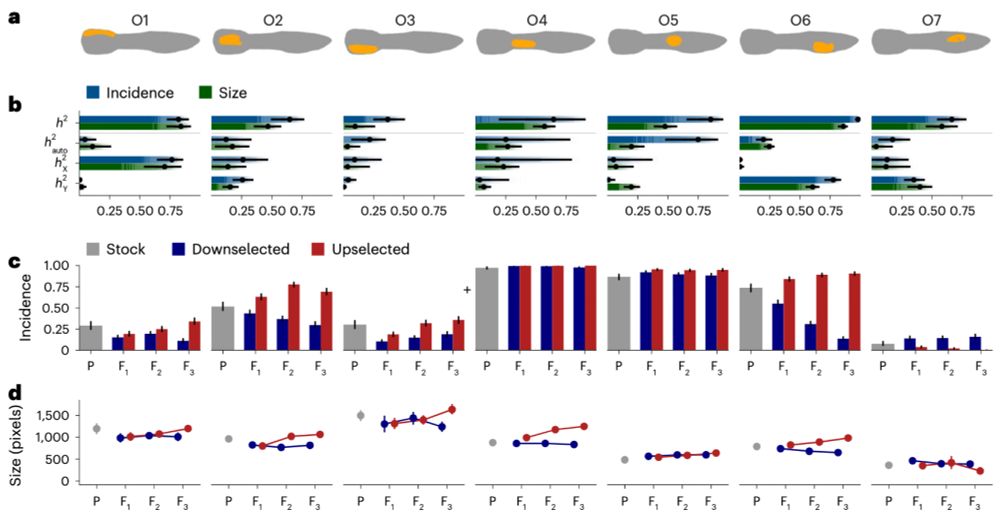
Orange ornaments are strongly heritable, and their incidence and size responded to selection. a, Pictograms of seven orange ornaments. b, Heritabilities of the incidence and size (when present) of each ornament. Dots and lines reflect point estimates and 95% credible intervals, and the gradient bars show the cumulative posterior density. c,d, The effect of selection on the incidence and size of orange ornaments. Bars and points represent means, with error bars showing 95% bootstrapped confidence intervals. x axes show consecutive generations. Sample size (number of fish); P generation: 300; downselected F 1, F2 and F3: 453, 570 and 441; upselected F 1, F2 and F3: 508, 513 and 444.
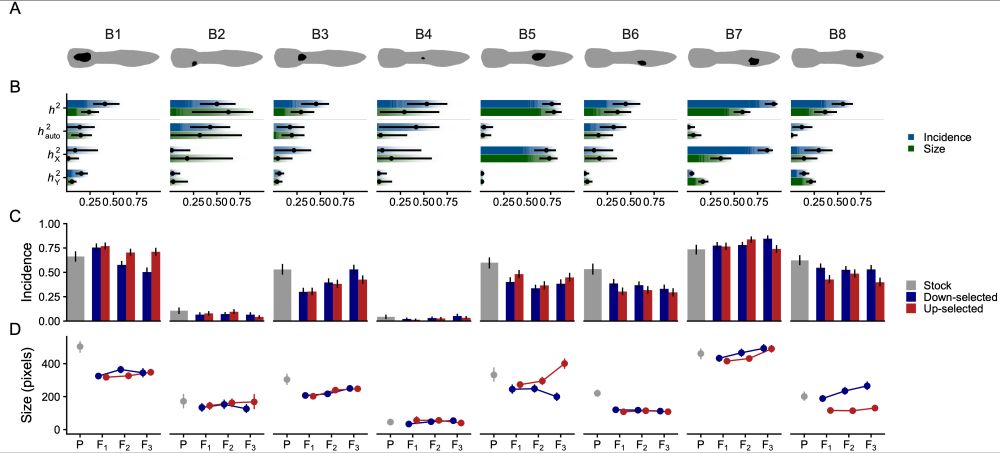
As in the first figure.
Among all this variation, we can distinguish 7 orange and 8 black ornaments. Together, these can combine into 32k different patterns, although we observe just 691.
Each of the ornaments have different contributions from the autosomes and the sex chromosomes. Only 2 show clear Y-linked inheritance.
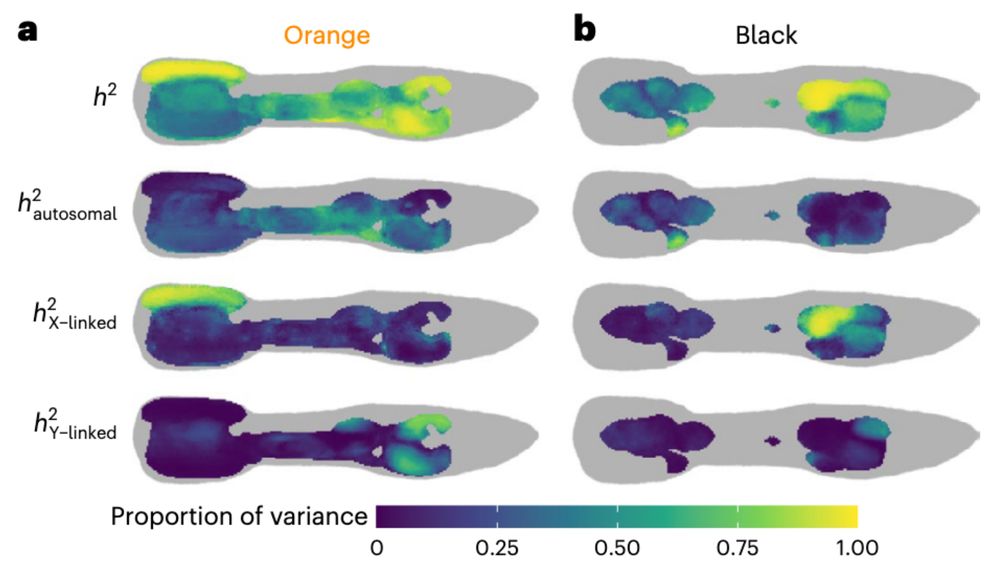
The localized heritability of colour is high, but the architecture is heterogeneous. a,b, The narrow-sense heritability of the presence of orange (a) and black (b) colour on the guppy body. For each heat map cell, a Bayesian animal model was used to estimate the contribution of additive genetic and environmental factors. Heritabilities are expressed as a proportion of the between-individual phenotypic variance. The autosomal, X-linked and Y-linked heritability add up to the total heritability. Body positions where the incidence of colour is less than 1% are coloured grey.
Combining the pedigree with >14k guppy photos, we can model the inheritance of ornamentation across the body. Localized heritability is very high overall. Each body location has its own genetic architecture. We see clear X- and Y-linked inheritance, but only for a minority of the body plan.
01.07.2025 18:13 — 👍 4 🔁 0 💬 1 📌 0
| Quantification of pattern variation. a, An overview of the phenotyping pipeline. From each photo, the fish is extracted, the body is aligned to a common reference shape using landmarks, and the position of orange and black colour is extracted.
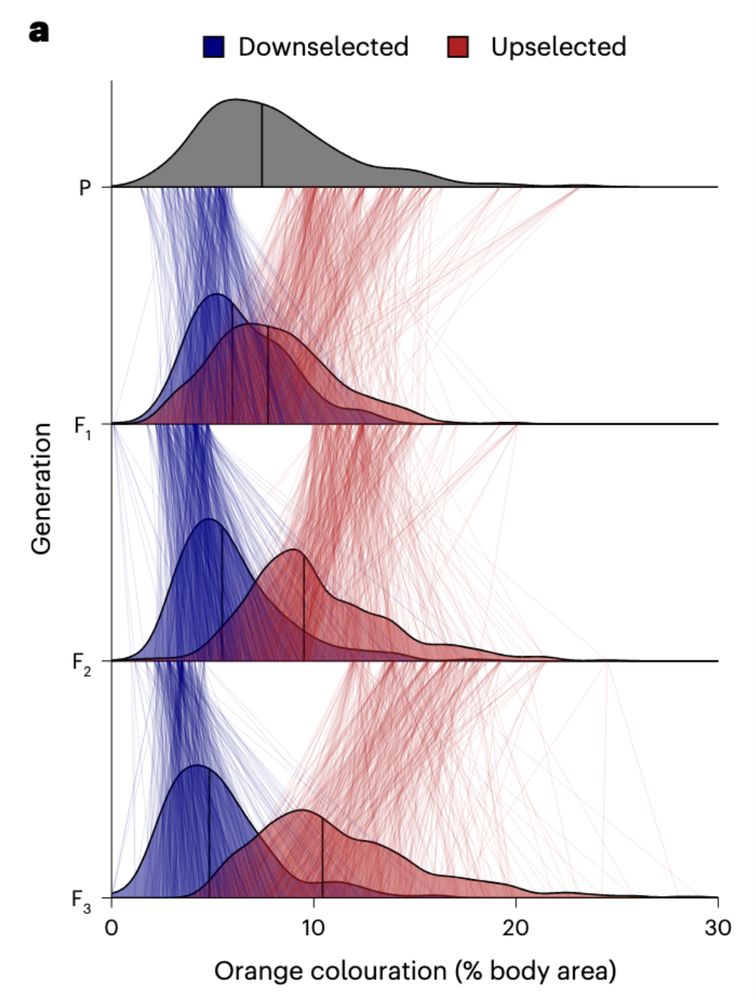
| Orange colour responds rapidly to selection. a, Density plots show the distribution of the percentage of orange colouration per generation and selection regime. Thin lines between generations connect fathers to their sons. Thick lines inside the densities show the median value of colour area.
We set up a selection experiment and phenotyped 3,200 males in a pedigree. Using a deep learning pipeline, we extracted all the ornamentation and aligned the images to a common reference shape.
In just three generations, our selection lines differed by 2x, confirming high heritability.